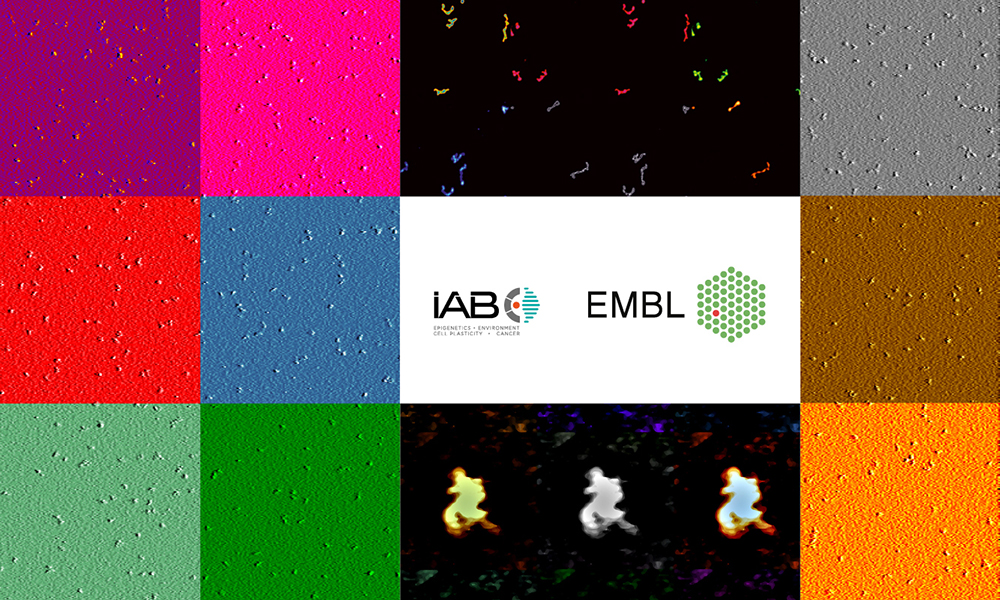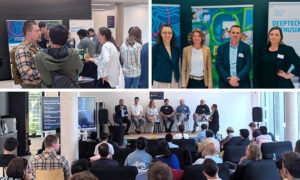
EMBL-IAB collaboration on the rise
Looking back at a fruitful year of the two institutes working together

The memorandum of understanding (MoU) signed between EMBL and the Institute for Advanced Biosciences (IAB) a year ago has already catalysed new grants for joint research projects related to cancer and infection biology, thereby deepening collaborative activities.
New grants to study non-coding RNAs
Researchers from EMBL Grenoble and IAB recently received funding from the Région Auvergne-Rhône-Alpes (AuRA) and from FINOVI – a foundation which supports infectious diseases research in France – to carry out studies on long non-coding RNA (lncRNA) involved in cancer suppression and viral infections.
These highly collaborative projects – the first to be funded within the framework of the MoU – will involve research groups and facilities from EMBL sites in Grenoble and Heidelberg, and structural biology infrastructure from the EPN campus. They will also leverage translational and clinical expertise through IAB and its collaboration with the Grenoble Alpes University Hospital (CHU).
The AuRA grant specifically funds collaborative projects between local institutions and international partners located in strategic geographical areas defined by the French government, in this case the Baden-Wuerttemberg region of Germany, where EMBL Heidelberg is situated.
“By attributing this grant, AuRA and FINOVI appreciate the role that EMBL Heidelberg will play as a strategic partner of regional scientific centres in Grenoble by adding value through the use of three core facilities: Genomics, Proteomics, and Advanced Light Microscopy,” explained EMBL Grenoble group leader Marco Marcia, who leads the project together with the IAB researcher André Verdel. “The involvement of facilities at IAB and EMBL showcases very well the interdisciplinarity and societal relevance of joining the research programmes of the two institutes.”
Through the two EMBL-IAB research projects, scientists will investigate MEG3, a very large RNA that influences the activity of the protein p53 – a key regulator of cell proliferation. The researchers will look at how MEG3, by stimulating p53, could potentially prevent cancer development and counteract viral infections.
Meeting of scientific minds
The new studies are well aligned with common research areas at EMBL and IAB, including epigenetics and infection biology. They also fit well within Grenoble’s research and innovation ecosystem, where several institutes and industries have a well-developed focus on health-related aspects.
In this respect, the MoU also catalysed the creation of new Grenoble-based scientific clubs to bring researchers in Grenoble together. The Grenoble Host-Pathogen Interactions Club and the Grenoble Drug Discovery Club follow the model of the existing Grenoble Epigenetics Club. Both clubs launched a series of virtual meetings in 2021, each gathering several hundreds of participants from Grenoble, other areas in France, and beyond.
A year of fruitful collaboration between both institutes concluded with an EMBL-IAB meeting on 22 November. Bringing in EMBL Rome’s Ana Boskovic as a speaker, the event supported the aim of increasing collaboration between IAB and all EMBL sites. “This inspiring meeting highlighted both long-running and new collaborations between the institutes, paving the way for more jointly funded projects,” said Head of EMBL Grenoble Stephen Cusack.
Une collaboration en plein essor
Retour sur une riche année de collaboration entre l’EMBL et l’IAB
La signature du protocole d’entente entre l’EMBL et l’Institute for Advanced Biosciences (IAB), il y a de cela un an, a déjà permis d’obtenir de nouvelles subventions pour des projets de recherche communs liés à la biologie du cancer et des infections. Plus généralement, elle a permis l’approfondissement des activités de collaboration entre les deux instituts.
De nouvelles subventions pour l’étude des ARN non-codants
Des chercheurs de l’EMBL Grenoble et de l’IAB ont récemment reçu des financements de la Région Auvergne-Rhône-Alpes (AuRA) et de la fondation FINOVI, qui soutient la recherche sur les maladies infectieuses en France. Leurs études porteront sur les longs ARN non-codants, impliqués dans la suppression du cancer et des infections virales.
Ces projets hautement collaboratifs sont les premiers à être financés dans le cadre du protocole d’entente. Ils impliqueront des groupes de recherche et des installations des sites de l’EMBL à Grenoble et à Heidelberg, ainsi que des infrastructures en biologie structurale du campus EPN à Grenoble. Ils tireront également parti de l’expertise clinique et translationnelle de l’IAB, grâce à sa collaboration avec le Centre Hospitalier Universitaire Grenoble Alpes.
La subvention de la Région Auvergne-Rhône-Alpes permet de financer plus spécifiquement des projets de collaboration entre des institutions locales et des partenaires internationaux, situés dans des zones géographiques stratégiques pour la région, telle que la région du Bade-Wurtemberg en Allemagne où se trouve l’EMBL Heidelberg.
“En attribuant ces financements, la Région Auvergne-Rhône-Alpes et FINOVI apprécient le rôle que le site de l’EMBL à Heidelberg joue en tant que partenaire stratégique des centres scientifiques régionaux de Grenoble. Il apportera une valeur ajoutée grâce à l’utilisation de trois services scientifiques centraux: les plateformes de Génomique, Protéomique et de Microscopie optique de pointe”, explique Marco Marcia, chef de groupe à l’EMBL Grenoble, qui dirige le projet avec André Verdel, chercheur à l’IAB. “L’implication des installations de l’IAB et de l’EMBL montre très bien l’interdisciplinarité et la pertinence sociétale des programmes de recherche des deux instituts.”
Dans le cadre de ces deux projets de recherche entre l’EMBL et l’IAB, les scientifiques étudieront MEG3, un long ARN qui influence l’activité de la protéine p53, un régulateur clé de la prolifération cellulaire. Les chercheurs étudieront comment MEG3, en stimulant p53, pourrait potentiellement prévenir le développement de cancers et contrer les infections virales.
Rencontres scientifiques
Ces nouvelles études s’inscrivent dans des domaines de recherche communs à l’EMBL et à l’IAB, particulièrement l’épigénétique et la biologie des infections. Elles s’inscrivent également fortement dans l’écosystème de recherche et d’innovation à Grenoble, où plusieurs instituts et industries s’intéressent de près au domaine de la santé.
À cet égard, le protocole d’entente a également catalysé la création de deux nouveaux clubs scientifiques grenoblois destinés à rassembler les chercheurs de la région. Le club de Grenoble sur les Intéractions hôte-pathogène et le club de Grenoble sur la Découverte de médicaments, qui suivent le modèle du club de Grenoble sur l’Épigénétique. Les deux clubs ont lancé une série de réunions virtuelles en 2021, chacune rassemblant plusieurs centaines de participants de Grenoble, mais également d’autres régions de France et d’ailleurs.
Cette riche année de collaboration s’est achevée par un séminaire entre les chercheurs de l’EMBL et de l’IAB, le 22 novembre dernier. Ana Boskovic, chef de groupe à l’EMBL Rome, figurait parmi les intervenant(e)s de cet événement, renforçant ainsi la collaboration entre l’IAB et les différents sites de l’EMBL. “Cette réunion a été très stimulante. Elle a mis en lumière de longues collaborations entre les instituts, d’autres plus récentes, et ouvre la voie à davantage de projets de financement conjoints”, a déclaré Stephen Cusack, responsable de l’EMBL Grenoble.


